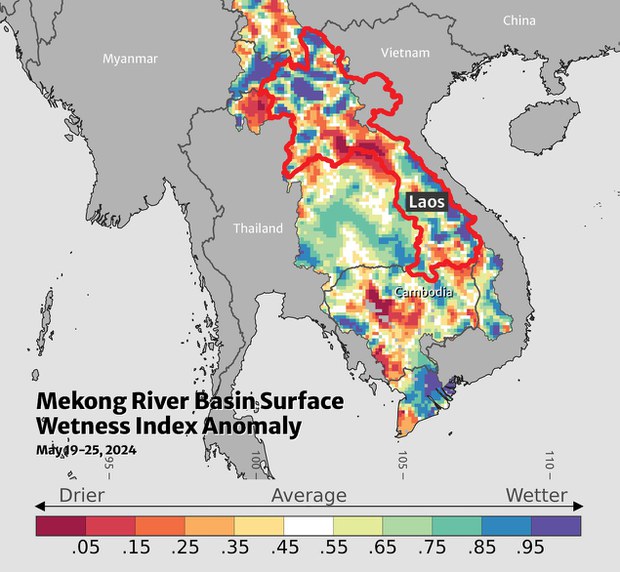Lao Farmers Facing Severe Water Shortage Due to Drought and Lack of Rain
Source: Radio Free Asia
Across Laos, a drop in the average amount of rainfall over the last five years is seriously affecting agricultural and electricity production, government officials told Radio Free Asia.
Farmers haven’t been able to plant rice or vegetables after a heat wave in April and May further hardened the ground and lowered water levels for rivers and streams down to just a trickle, several provincial officials said.
“We can do nothing,” a Department of Agriculture and Forestry official in southern Champassak province said. “We can’t plow. All we can do is wait. Wait for water or rainfall.”

This trend has been in place for several years – an ominous sign on World Environment Day, which is also Lao National Environment Day, which falls on Wednesday. Rivers and smaller streams have been too dry and the weather has been too hot to begin the rainy season planting.
Also, the rainfall shortage has left Laos’ dam reservoirs at just 30 percent water capacity, causing electricity production to drop 10 percent from last year, according to an official from the state-owned power company, Electricite du Laos.

“Every month, we have a meeting to discuss the water situation in the country – more specifically, about the amount of water we need and the amount of water that is available,” said a Lao Ministry of Natural Resources and Environment, who like other sources in this report requested anonymity for safety reasons.
“However, until now, we haven’t found any solution to the shortage,” he said.
The deforestation challenge
Lao Prime Minister Sonexay Siphandone said at a Cabinet meeting last month that his government is stepping up its monitoring of climate change and its impacts.
On Monday, he called on Laotians to stop cutting down trees, saying that illegal logging and deforestation have led to increased forest fires, degraded soil and flooding.
The prime minister restated the government’s goal of increasing nationwide forest coverage from 40% to 70%.
“Deforestation, land degradation, land clearance, and forest fire have been intensifying in our country,” he said. “Together we can stop destroying forests to restore soil and fight against drought and floods.”
Because trees and soil can absorb carbon, forest restoration is believed to be an important way to counter climate change. But revitalized forests can also play a role in reducing heat and regulating rainfall patterns, according to the World Resources Institute.
The Lao government has issued several directives banning illegal logging and the illegal export of wood, including a strongly worded decree in 2015. But deforestation has continued, including by farmers who use slash-and-burn tactics to clear land to grow rice or cassava.
In practice, it’s very difficult for government officials to tell people that they can’t use nearby land to make a living, a Lao environmentalist said.
“Stopping deforestation is a big challenge,” he said. “Most Laotians are poor farmers who rely on the forest for survival.”
The data
More deforestation could mean a continuation of Laos’ declining rainfall rate. Before 2019, Laos usually received an average of 3,000 millimeters (118 inches) of rainfall a year, according to the World Bank.
But in 2019, only 1,460 millimeters (57 inches) fell. In 2020, it was 1,834 millimeters (72 inches), and in 2021 and 2022, there were 1,755 millimeters (69 inches) and 2,038 millimeters (80 inches) of rainfall, according to the World Bank
The trend continued into 2023 and the first five months of this year, according to the Champassak provincial official
“It’s rained only once in this area this year, “ he said. “If you look at rice fields right now, you’ll see only weeds, but no water.”

